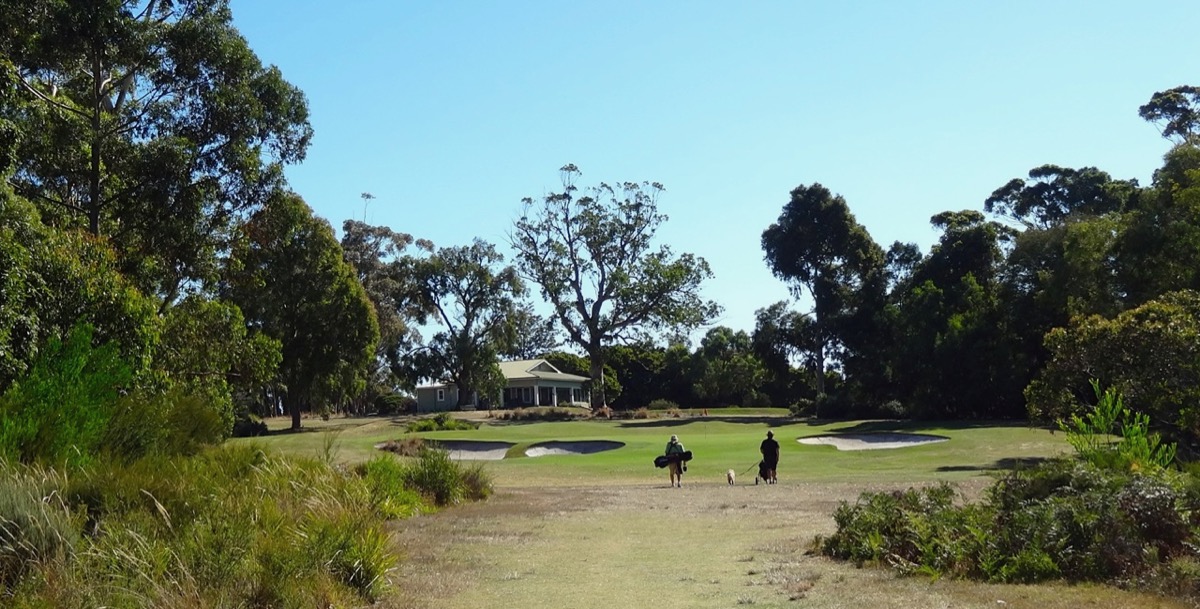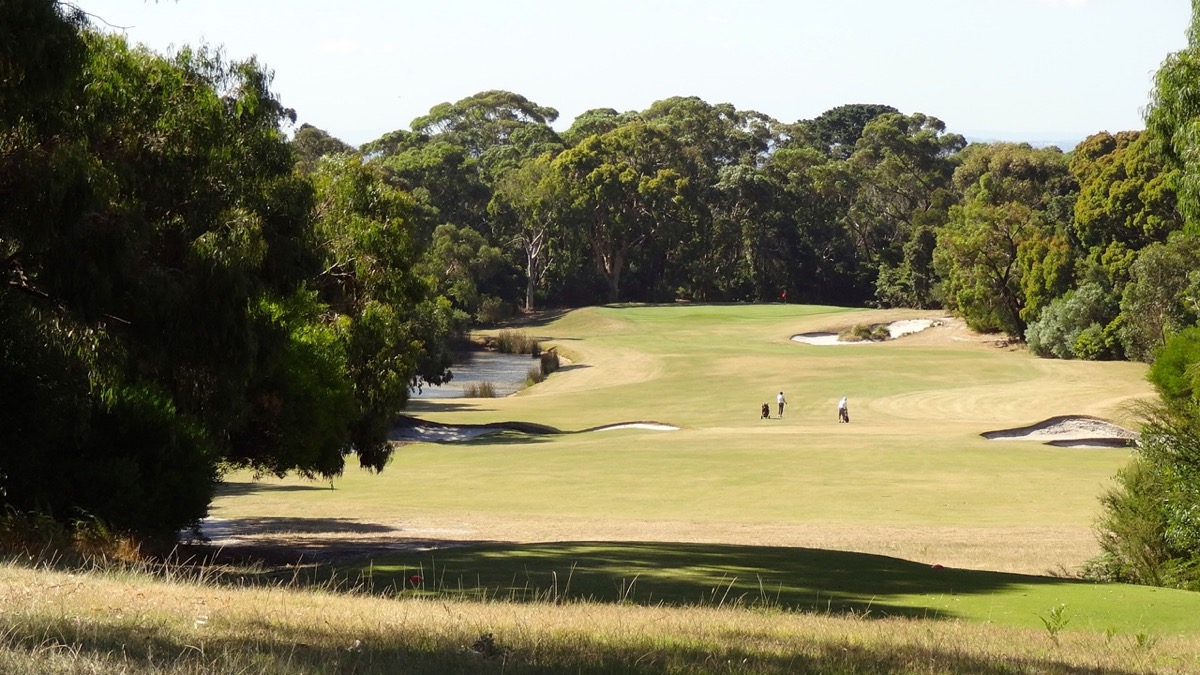 Frankston GC- hole 9 & clubhouse
Frankston GC- hole 9 & clubhouse
Built in 1913 Frankston GC became known as "The Millionaires Club" due to the pedigree of the handful of businessmen who conceived and financed the project. The members prefer to call it "the little course" as it is 9 holes only, and not overly long at that. But don't for a moment think this course is a pushover. The greens are small, and there is enough trouble to be found on each hole to reward strategic and precise golf.
Forget where you are, and you would be forgiven for thinking you were playing one of the world class sand belt courses up the road. It really is that good!
In my opinion the standout hole is the par 5 , 5th hole with elevated tee, ample bunkering to avoid off the tee and the 2nd shot, water to the left on the 2nd shot and a tight approach...
 Frankston GC- hole 5
Frankston GC- hole 5
Right from the start the founding members put in place a planting program to ensure that the course is set in a virtual botanic garden of eucalypts...
 Frankston GC bunkering
Frankston GC bunkering
 Frankston GC- more bunkering
Frankston GC- more bunkering
With good reason the membership keeps this hidden gem from the public eye, and indeed many have not even heard of it. But if you EVER get an invitation to play Frankston GC, pinch yourself and then take up the offer as quick as you can!!
I have also included a more complete report from eminent golf architect Paul Mogford for your edification...
Golf Tours
The Travelling Golfer can tailor a golf trip to suit your group.
For suggested destinations see Golf Tours- Victoria
Enquiries
For further information on a tailored golf trip please enquire here:

Course Review - Frankston Golf Club
This article courtesy of the Golf Architecture Magazine
HIDDEN GEM - Frankston Golf Club
Frankston, Victoria
Upon first inspection you may be excused for concluding that the Frankston Golf Club (FGC) is a modest venue for the pursuit of golf. However, as the initiated well know, one must be immersed in the remarkable history of the club to fully appreciate this ‘hidden gem’.
‘The Little Course’, as it is affectionately known, was first laid out in 1913 with nine holes spaciously arranged on 246 acres of land. There is little record of the original designer of the course, however there is a reference in the Club’s minutes of the 3rd of February 1913, to a Mr. R. Banks, who reported on the measuring and planning of the nine-hole course. A further nine holes were planned for but were never realized, which is perhaps fortuitous, as much of today’s character is afforded by the quaintness of nine holes. Its founders Mr. A.H Sargood and Mr. R. Debenham, must be granted much of the credit for ‘The Little Course’, for it was ‘their vision and energy’ which led to its creation and continued development.
Steeped in history, it is difficult not to be overawed by the many stories of generosity, dedication and perseverance, which have shaped this remarkable course. In 1917, after the events of World War 1, and at the suggestion of Mr. A. Curries, the first plantings of introduced native tree specimens took place (100 x Eucalyptus ficifolia). This would begin approximately three decades of intensive landscape development, which would forever change the future of the FGC. Noted botanist and horticulturalist, Mr. E. E. Pescott was invited to prepare a tree planting scheme. Of particular interest is the planting of Eucalyptus ficifolia, E. calophylla, E. globulus, Acacia elata, A. prominens, Pittosporum undulatum, Callitris sp., and Angophora costata, which thrive on the FGC today. In fact Debenham, having purchased 500 Eucalyptus ficifolia, donated 250 for planting at the Metropolitan Golf Club, which so began a practice of the two clubs exchanging many plants, such as Thryptomene sp. to Metropolitan, and Prostanthera rotundifolia (of which little remains at Metro) from Metropolitan to ‘The Little Course’.
Immediately following Pescott’s scheme the first Plantation Committee was formed consisting of Mr. J. G. Mann and Mr. W. R. Grimwade, who would later be ably assisted by Course Curator Mr. J. Swanson up until his retirement in 1951. Aims for the Landscape Development of FGC were written (most likely a first for a golf club) and many hundreds of plant specimens were subsequently propagated, transplanted, while seeds were collected and broadcast onto prepared ploughed seed beds.
However, the bush fires of January 1944 devastated much of these planting, after which Mann noted; ‘the fires swept the course and destroyed everything which comprised the foregoing history’ of the FGC. It was not until October 1950 did Mann note that ‘fortunately immediately after fire, light rain and ground covered inches deep with warm ashes, ideal conditions for germination….millions of self sown seedlings of every variety everywhere. When war over (WWII) and labour obtained….course cleaned up and burnt timber disposed of, greens remade, many 100’s of seedlings transplanted. Today links are once more in splendid order and as beautiful and attractive as before the fire.
Not to be deterred, in Mann’s last entry after the fire of 1944 he refers to Grimwade and Swanson’s journey to Western Australia in September of 1947 to collect specimens for planting at the FGC. Many of which survive today on the course, such as; Chamaelaucium axillare, Cliathus sp., Hypocalymm spp., Anigozanthum sp.,Thryptomene saxicola and the small eucalypt E. forrestiana. In addition plantings from the Grampians and NSW all contribute to make FGC ‘renowned for its fine collection of a colourful and interesting range of Australian native plants’ which continues to attract interest to this day.
Such was, and is, the greatness of the native landscape plantings of the FGC, it is likely to have been a significant factor in attracting notable visitors to the course, along with the considerable native fauna which was kept in an open range type zoo, in and around the links. FGC, in the mid to late 30’s, according to the records of Swanson, was responsible for giving Healesville Sanctuary their first emus, koalas and kangaroos, as well as providing young kangaroos and emus to the Melbourne Zoo.
‘The Little Course’ has received many distinguished visitors, and reportedly it was not unusual during the 20’s to see eighteen chauffeurs in the car park. The motor car was not always confined to the car park. In the 30’s Mr. Archie Currie, established a scenic drive around part of the course, which showcased the colorful native flora and fauna. The Duke of Gloucester’s Drive, as it came to be called, began at the clubhouse, running alongside the 1st fairway, turned around three parts down the 2nd, up alongside the 4th to the green and then returned back to the clubhouse. In addition, Sir Robert Knox was also largely responsible for other official and unofficial visits of Royalty to FGC. In 1954, Queen Elizabeth and the Prince of Wales visited, with the Prince planting a Eucalytus ficifolia beside the 9th green, which commemorated the coronation of King George XII. Amongst others the English cricket team visited regularly, as well Sir Dallas Brooks, Lord Somers and Lady Somers who frequented the course.
Yet another interesting piece of history is that in 1921 Mr. A. H. Sargood bought back to FGC, via boat, two motor mowers from England, namely a Burgess 16 inch and a Busy-bee 30 inch.
Significantly they were the first motor mowers to come to Australia, at a time when all other courses, including; Royal Melbourne and Metropolitan were cutting fairways and greens with horse drawn ‘slashers’. Reportedly vistors to FGC would come and look in amazement at the sight of these motorized wonders, which revolutionized playing conditions.
Maintenance practices were to say the least minimal by today’s standards. It was not until 1929, that manure or super-phosphate was utilized. Even then fertilizing only occurred once every four years.
Course Superintendent Mr. J. Geary, (1986 – present day), is respectful of FGC’s unique history and realizes the important role he and his staff have in preserving and enhancing this unique course. Geary is lauded by many of his peers for his ‘natural systems’ approach to turf grass management and his willingness to work with the natural environment.
With a limited budget, and just two other staff members, the team produces high quality sustainable playing surfaces, without subscribing to the ‘high input’ regimes which many other courses are slaves to, in order to maintain perceived aesthetic excellence.
Today FGC occupies some 115 acres, the result of various sub-divisions of land for residential purposes. The land still however retains the same three essential ingredients of the original parcel of 246 acres, namely - topography, sandy soils and native vegetation.
Changes to the course have been few since the rebuild of greens after the devastating fire of 1944. Most notably, the 9th hole was reconstructed in 1996, in order to rectify drainage problems and to strengthen what was considered a strategically ‘weak’ hole.
Otherwise, modifications have been limited to improving upon basic elements of the course to take advantage of the natural attributes of the site. This sound and prudent philosophy recognises the inherent potential of any golf course and to allow for it to evolve and improve, within the bounds of its original conception, where warranted.
The strength of FGC lies not only within its history, but, within the simplicity of its physical composition. There is little in the way of fussy mounding and complicated green complexes. The course is relatively short in length, measuring some 2900m, but the greens are small and sloping as they rely largely on surface drainage.
The golfing experience, both conscious and sub-conscious, is dream-like, and one cannot help but feel the presence and soul of golfers past. The routing takes the golfer on a journey, which capitalizes on various natural and contrived views in and out of the property, as one moves from enclosed areas of the course to higher ground.
To a large extent it is the historic planting which controls and contributes much to the quality of this ‘hidden gem’. Frankston Golf Club is an excellent example of the power of landscape planning for the enhancement of a golf course.
by Paul Mogford
courtesy of the Golf Architecture Magazine - click for more


